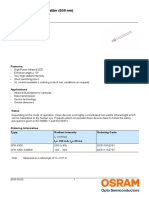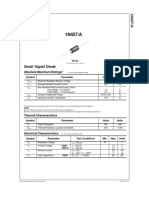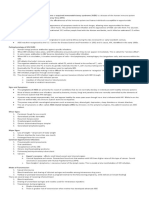Tsal7600 1211438
Tsal7600 1211438
Uploaded by
Đức LêCopyright:
Available Formats
Tsal7600 1211438
Tsal7600 1211438
Uploaded by
Đức LêOriginal Title
Copyright
Available Formats
Share this document
Did you find this document useful?
Is this content inappropriate?
Copyright:
Available Formats
Tsal7600 1211438
Tsal7600 1211438
Uploaded by
Đức LêCopyright:
Available Formats
TSAL7600
Vishay Semiconductors
High Power Infrared Emitting Diode, 950 nm, GaAlAs/GaAs
Description
TSAL7600 is a high efficiency infrared emitting diode
in GaAlAs on GaAs technology, molded in clear plas-
tic packages.
In comparison with the standard GaAs on GaAs tech-
nology these emitters achieve more than 100 % radi-
ant power improvement at a similar wavelength.
The forward voltages at low current and at high pulse
current roughly correspond to the low values of the 94 8389
standard technology. Therefore these emitters are
ideally suitable as high performance replacements of
standard emitters.
Features Applications
• Extra high radiant power and radiant • Infrared remote control units with high power
intensity requirements
• High reliability • Free air transmission systems
• Low forward voltage
e2
• Infrared source for optical counters and card
• Suitable for high pulse current operation readers
• Standard T-1¾ (∅ 5 mm) package • IR source for smoke detectors
• Angle of half intensity ϕ = ± 30°
• Peak wavelength λp = 940 nm
• Good spectral matching to Si photodetectors
• Lead (Pb)-free component
• Component in accordance to RoHS 2002/95/EC
and WEEE 2002/96/EC
Absolute Maximum Ratings
Tamb = 25 °C, unless otherwise specified
Parameter Test condition Symbol Value Unit
Reverse voltage VR 5 V
Forward current IF 100 mA
Peak forward current tp/T = 0.5, tp = 100 µs IFM 200 mA
Surge forward current tp = 100 µs IFSM 1.5 A
Power dissipation PV 210 mW
Junction temperature Tj 100 °C
Operating temperature range Tamb - 55 to + 100 °C
Storage temperature range Tstg - 55 to + 100 °C
Soldering temperature t ≤ 5 sec, 2 mm from case Tsd 260 °C
Thermal resistance junction/ RthJA 350 K/W
ambient
Document Number 81015 www.vishay.com
Rev. 1.6, 28-Nov-06 1
TSAL7600
Vishay Semiconductors
Electrical Characteristics
Tamb = 25 °C, unless otherwise specified
Parameter Test condition Symbol Min Typ. Max Unit
Forward voltage IF = 100 mA, tp = 20 ms VF 1.35 1.6 V
IF = 1 A, tp = 100 µs VF 2.6 3 V
Temp. coefficient of VF IF = 100 mA TKVF - 1.3 mV/K
Reverse current VR = 5 V IR 10 µA
Junction capacitance VR = 0 V, f = 1 MHz, E = 0 Cj 25 pF
Optical Characteristics
Tamb = 25 °C, unless otherwise specified
Parameter Test condition Symbol Min Typ. Max Unit
Radiant intensity IF = 100 mA, tp = 20 ms Ie 15 25 75 mW/sr
IF = 1.0 A, tp = 100 µs Ie 120 200 mW/sr
Radiant power IF = 100 mA, tp = 20 ms φe 35 mW
Temp. coefficient of φe IF = 20 mA TKφe - 0.6 %/K
Angle of half intensity ϕ ± 30 deg
Peak wavelength IF = 100 mA λp 940 nm
Spectral bandwidth IF = 100 mA Δλ 50 nm
Temp. coefficient of λp IF = 100 mA TKλp 0.2 nm/K
Rise time IF = 100 mA tr 800 ns
Fall time IF = 100 mA tf 800 ns
Virtual source diameter ∅ 1.8 mm
Typical Characteristics
Tamb = 25 °C, unless otherwise specified
250 250
PV - Power Dissipation (MW)
IF - Forward Current (mA)
200 200
150 150
R thJA
100 100
RthJA
50 50
0 0
0 20 40 60 80 100 0 20 40 60 80 100
94 7957 Tamb - Ambient Temperature (°C) 96 11986 Tamb - Ambient Temperature (°C)
Figure 1. Power Dissipation vs. Ambient Temperature Figure 2. Forward Current vs. Ambient Temperature
www.vishay.com Document Number 81015
2 Rev. 1.6, 28-Nov-06
TSAL7600
Vishay Semiconductors
10 1 1000
I e - Radiant Intensity (mW/sr)
I F - Forward Current (A)
I FSM = 1 A (Single Pulse) 100
t p/T = 0.01
10 0 0.05 10
0.1
0.5 1
1.0
10 -1 0.1
10 -2 10 -1 10 0 10 1 10 2 100 101 102 103 104
96 11987 t p - Pulse Duration (ms) 14255 I F - Forward Current (mA)
Figure 3. Pulse Forward Current vs. Pulse Duration Figure 6. Radiant Intensity vs. Forward Current
104 1000
IF - Forward Current (mA)
Φ e - Radiant Power (mW)
103 100
102 10
tP = 100 µs
tP/T = 0.001
101 1
100 0.1
0 1 2 3 4 10 0 10 1 10 2 10 3 10 4
13600 VF - Forward Voltage (V) 13602 I F - Forward Current (mA)
Figure 4. Forward Current vs. Forward Voltage Figure 7. Radiant Power vs. Forward Current
1.2 1.6
V Frel - Relative Forward Voltage (V)
1.1
1.2
IF = 10 mA IF = 20 mA
I e rel ; Φe rel
1.0
0.8
0.9
0.4
0.8
0.7 0
0 20 40 60 80 100 - 10 0 10 50 100 140
94 7990 T amb - Ambient Temperature (°C) 94 7993 T amb - Ambient Temperature (°C)
Figure 5. Relative Forward Voltage vs. Ambient Temperature Figure 8. Rel. Radiant Intensity/Power vs. Ambient Temperature
Document Number 81015 www.vishay.com
Rev. 1.6, 28-Nov-06 3
TSAL7600
Vishay Semiconductors
0° 10° 20°
1.25 30°
I e rel - Relative Radiant Intensity
Φe rel - Relative Radiant Power
1.0
40°
0.75 1.0
0.9 50°
0.5
0.8 60°
0.25 70°
0.7
IF = 100 mA 80°
0
890 940 990 0.6 0.4 0.2 0 0.2 0.4 0.6
14291 λ - Wavelength (nm) 94 8011
Figure 9. Relative Radiant Power vs. Wavelength Figure 10. Relative Radiant Intensity vs. Angular Displacement
Package Dimensions in mm
20327
www.vishay.com Document Number 81015
4 Rev. 1.6, 28-Nov-06
TSAL7600
Vishay Semiconductors
Ozone Depleting Substances Policy Statement
It is the policy of Vishay Semiconductor GmbH to
1. Meet all present and future national and international statutory requirements.
2. Regularly and continuously improve the performance of our products, processes, distribution and operating
systems with respect to their impact on the health and safety of our employees and the public, as well as
their impact on the environment.
It is particular concern to control or eliminate releases of those substances into the atmosphere which are
known as ozone depleting substances (ODSs).
The Montreal Protocol (1987) and its London Amendments (1990) intend to severely restrict the use of ODSs
and forbid their use within the next ten years. Various national and international initiatives are pressing for an
earlier ban on these substances.
Vishay Semiconductor GmbH has been able to use its policy of continuous improvements to eliminate the use
of ODSs listed in the following documents.
1. Annex A, B and list of transitional substances of the Montreal Protocol and the London Amendments
respectively
2. Class I and II ozone depleting substances in the Clean Air Act Amendments of 1990 by the Environmental
Protection Agency (EPA) in the USA
3. Council Decision 88/540/EEC and 91/690/EEC Annex A, B and C (transitional substances) respectively.
Vishay Semiconductor GmbH can certify that our semiconductors are not manufactured with ozone depleting
substances and do not contain such substances.
We reserve the right to make changes to improve technical design
and may do so without further notice.
Parameters can vary in different applications. All operating parameters must be validated for each
customer application by the customer. Should the buyer use Vishay Semiconductors products for any
unintended or unauthorized application, the buyer shall indemnify Vishay Semiconductors against all
claims, costs, damages, and expenses, arising out of, directly or indirectly, any claim of personal
damage, injury or death associated with such unintended or unauthorized use.
Vishay Semiconductor GmbH, P.O.B. 3535, D-74025 Heilbronn, Germany
Document Number 81015 www.vishay.com
Rev. 1.6, 28-Nov-06 5
Legal Disclaimer Notice
Vishay
Disclaimer
All product specifications and data are subject to change without notice.
Vishay Intertechnology, Inc., its affiliates, agents, and employees, and all persons acting on its or their behalf
(collectively, “Vishay”), disclaim any and all liability for any errors, inaccuracies or incompleteness contained herein
or in any other disclosure relating to any product.
Vishay disclaims any and all liability arising out of the use or application of any product described herein or of any
information provided herein to the maximum extent permitted by law. The product specifications do not expand or
otherwise modify Vishay’s terms and conditions of purchase, including but not limited to the warranty expressed
therein, which apply to these products.
No license, express or implied, by estoppel or otherwise, to any intellectual property rights is granted by this
document or by any conduct of Vishay.
The products shown herein are not designed for use in medical, life-saving, or life-sustaining applications unless
otherwise expressly indicated. Customers using or selling Vishay products not expressly indicated for use in such
applications do so entirely at their own risk and agree to fully indemnify Vishay for any damages arising or resulting
from such use or sale. Please contact authorized Vishay personnel to obtain written terms and conditions regarding
products designed for such applications.
Product names and markings noted herein may be trademarks of their respective owners.
Document Number: 91000 www.vishay.com
Revision: 18-Jul-08 1
Mouser Electronics
Authorized Distributor
Click to View Pricing, Inventory, Delivery & Lifecycle Information:
Vishay:
TSAL7600
You might also like
- Grade 12 Nature and Background of OutdoorDocument12 pagesGrade 12 Nature and Background of OutdoorDanica Caliso100% (1)
- Vishay TSAL6400 Infrared LEDDocument6 pagesVishay TSAL6400 Infrared LEDjpcoteNo ratings yet
- Tsal7200: High Power Infrared Emitting Diode, 950 NM, Gaalas/GaasDocument6 pagesTsal7200: High Power Infrared Emitting Diode, 950 NM, Gaalas/GaasvelizarkoNo ratings yet
- TSTS710Document5 pagesTSTS710MustaNo ratings yet
- Vfir12led - en USDocument6 pagesVfir12led - en UStheimagingsourceNo ratings yet
- Irl 81 A - en - 2Document15 pagesIrl 81 A - en - 2Muhammad AlifNo ratings yet
- SFH 4546 - enDocument14 pagesSFH 4546 - enOzel Ders YasarNo ratings yet
- 1N4148 SMD PDFDocument4 pages1N4148 SMD PDF3degreesNo ratings yet
- LedspiroDocument20 pagesLedspirorogeriocorrea601No ratings yet
- Sfh+4770s+a01 enDocument17 pagesSfh+4770s+a01 enKen DizzeruNo ratings yet
- BPV10NFDocument5 pagesBPV10NFהליכות ג'יין נהריהNo ratings yet
- High Power Infrared Emitter (940 NM) : FeaturesDocument9 pagesHigh Power Infrared Emitter (940 NM) : FeaturesCharlieOdinocoNo ratings yet
- SFH 4356 - enDocument16 pagesSFH 4356 - enroberto-741945No ratings yet
- Small Signal Fast Switching Diodes: Vishay SemiconductorsDocument4 pagesSmall Signal Fast Switching Diodes: Vishay SemiconductorsDennisSendoyaNo ratings yet
- High Power Infrared Emitter (850 NM) : FeaturesDocument9 pagesHigh Power Infrared Emitter (850 NM) : FeaturesDavi HerculanoNo ratings yet
- Infrared Emitter (850 NM) : FeaturesDocument9 pagesInfrared Emitter (850 NM) : FeaturesMoch Irfan FirdausNo ratings yet
- SFH4555Document9 pagesSFH4555Aladár KissNo ratings yet
- Infrared Emitter (850 NM) : FeaturesDocument10 pagesInfrared Emitter (850 NM) : FeaturesDaniel ThomasNo ratings yet
- BYV255V: High Efficiency Fast Recovery Rectifier DiodesDocument5 pagesBYV255V: High Efficiency Fast Recovery Rectifier DiodesaleksNo ratings yet
- SFH 4547 - enDocument16 pagesSFH 4547 - enMultiverse GamerNo ratings yet
- Diodo - SMD - 1810101110 - Jiangsu Changjing Electronics Technology Co - LTD 1N4148WS - C2128Document2 pagesDiodo - SMD - 1810101110 - Jiangsu Changjing Electronics Technology Co - LTD 1N4148WS - C2128DaniNo ratings yet
- Tugas 1Document6 pagesTugas 1I Made WNo ratings yet
- SFH 4545_EN-2Document16 pagesSFH 4545_EN-2leclercqedouard300No ratings yet
- Small Signal Diode: Absolute Maximum RatingsDocument2 pagesSmall Signal Diode: Absolute Maximum RatingsZoltán ÁgostonNo ratings yet
- SFH 4714a PDFDocument13 pagesSFH 4714a PDFGround ViewNo ratings yet
- BAY73 Diodo FairchildDocument3 pagesBAY73 Diodo FairchildqiwiNo ratings yet
- Silicon Epitaxial Planar Diode: ApplicationsDocument4 pagesSilicon Epitaxial Planar Diode: ApplicationsZoltán ÁgostonNo ratings yet
- SFH+4052 enDocument17 pagesSFH+4052 enatulprajapati2807No ratings yet
- SMT1050 PDFDocument7 pagesSMT1050 PDFAli ShanNo ratings yet
- BPW41N Photodiode-DatasheetDocument5 pagesBPW41N Photodiode-DatasheetMarco ReisNo ratings yet
- PIN Diode: FeaturesDocument3 pagesPIN Diode: FeaturesthanhhavdtNo ratings yet
- IR OSLUX (810nm) - 36° / 8° Tilted: FeaturesDocument12 pagesIR OSLUX (810nm) - 36° / 8° Tilted: FeaturesGround ViewNo ratings yet
- SFH 4770S PDFDocument13 pagesSFH 4770S PDFGround ViewNo ratings yet
- TEFT4300 VishayTelefunkenDocument5 pagesTEFT4300 VishayTelefunkenDaniel PradoNo ratings yet
- Sanken Electric Co., Ltd. FMN-4306S: Downloaded FromDocument5 pagesSanken Electric Co., Ltd. FMN-4306S: Downloaded FromcomphomeNo ratings yet
- Silicon Epitaxial Planar Type: For Small Current Rectification Db2J316 in Ssmini2 Type Package FeaturesDocument4 pagesSilicon Epitaxial Planar Type: For Small Current Rectification Db2J316 in Ssmini2 Type Package FeaturesSatishNo ratings yet
- SFH 4170S - en PDFDocument18 pagesSFH 4170S - en PDFGround ViewNo ratings yet
- Temis00993 1Document5 pagesTemis00993 1henrykwolek15No ratings yet
- Fast Rectifier Diod 60P-400Document5 pagesFast Rectifier Diod 60P-400ge_bdNo ratings yet
- Data SheetDocument4 pagesData SheetAndres GalvezNo ratings yet
- STTH 506 DDocument5 pagesSTTH 506 DdcesentherNo ratings yet
- Rectifier Diodes BYV29F, BYV29X Series Ultrafast: Features Symbol Quick Reference DataDocument7 pagesRectifier Diodes BYV29F, BYV29X Series Ultrafast: Features Symbol Quick Reference DataMiguel AngelNo ratings yet
- Led Ope5594Document2 pagesLed Ope5594docrobb_No ratings yet
- Diode Bas16Document4 pagesDiode Bas16emericld9No ratings yet
- FH4550 DatasheetDocument7 pagesFH4550 Datasheetsqwer888No ratings yet
- Silicon Epitaxial Planar Diodes: FeaturesDocument4 pagesSilicon Epitaxial Planar Diodes: FeaturesfrancovellajuniorNo ratings yet
- Small Signal Diode: Absolute Maximum RatingsDocument1 pageSmall Signal Diode: Absolute Maximum RatingslejigeNo ratings yet
- Small Signal Diode: Symbol Parameter Value UnitDocument2 pagesSmall Signal Diode: Symbol Parameter Value UnitJoko RusmansyahNo ratings yet
- SFH 213 - enDocument15 pagesSFH 213 - ennyolczas.aronNo ratings yet
- BPW 34Document6 pagesBPW 34Mirela StanivukNo ratings yet
- FFPF 60 B 150 DsDocument6 pagesFFPF 60 B 150 DssakNo ratings yet
- STTH3003CW: High Frequency Secondary RectifierDocument5 pagesSTTH3003CW: High Frequency Secondary RectifiermikolaNo ratings yet
- FFPF10U60DN FairDocument4 pagesFFPF10U60DN Fairалексей ЛфNo ratings yet
- Datasheet Dropp DoidaDocument2 pagesDatasheet Dropp DoidaHAR Radio 2020No ratings yet
- Technical Data Sheet 5mm Infrared LED, T-1 3/4: FeaturesDocument6 pagesTechnical Data Sheet 5mm Infrared LED, T-1 3/4: FeaturesDuta HastaNo ratings yet
- CTK TK1N4148WTDocument3 pagesCTK TK1N4148WT1451667239No ratings yet
- Product Features Applications: 220V 20A Fred June 2015 Rohs CompliantDocument3 pagesProduct Features Applications: 220V 20A Fred June 2015 Rohs CompliantRiskyNo ratings yet
- Ly+etsf enDocument22 pagesLy+etsf enAndrey PolupanNo ratings yet
- F10U60SDocument4 pagesF10U60SWiliGonzálezNo ratings yet
- Fast Rectifier Diod 30PI - 400Document5 pagesFast Rectifier Diod 30PI - 400ge_bdNo ratings yet
- III-8-CĐH-Smart FactoryDocument72 pagesIII-8-CĐH-Smart FactoryĐức LêNo ratings yet
- Eng 04 00120Document12 pagesEng 04 00120Đức LêNo ratings yet
- Final PresentationDocument15 pagesFinal PresentationĐức LêNo ratings yet
- Upgrading Automotive Electronics Study Equipment at TTK UasDocument80 pagesUpgrading Automotive Electronics Study Equipment at TTK UasĐức LêNo ratings yet
- Structural Materials: 1. Metals 2. Polymers 3. Ceramics 4. CompositesDocument43 pagesStructural Materials: 1. Metals 2. Polymers 3. Ceramics 4. Compositesdjsiraj834No ratings yet
- Gastric Function TestDocument41 pagesGastric Function TestvigneshNo ratings yet
- DS-1 Vol. 3 Table 2.1-2.2 Fig. 2.7 To 2.12Document11 pagesDS-1 Vol. 3 Table 2.1-2.2 Fig. 2.7 To 2.12Chandrasekhar Sonar100% (1)
- Station Title: Assessment of Delusional Jealousy: Casc Linked OSCEDocument7 pagesStation Title: Assessment of Delusional Jealousy: Casc Linked OSCEKaram Ali ShahNo ratings yet
- FizuhaDocument4 pagesFizuhaArmands TomašsNo ratings yet
- Cardiovascular Disease in DentalDocument2 pagesCardiovascular Disease in DentalGhee MoralesNo ratings yet
- Synthesis of Nickel Nanoparticles by SolDocument5 pagesSynthesis of Nickel Nanoparticles by SolHarden PatilNo ratings yet
- Philippine Airlines, Inc. Vs HassaramDocument15 pagesPhilippine Airlines, Inc. Vs HassaramMiakaNo ratings yet
- 162K1Document36 pages162K1Wan HaziqNo ratings yet
- BS en 806-4-2010Document56 pagesBS en 806-4-2010irdynamics.2020No ratings yet
- WF Concrete Order Testing WMPDocument16 pagesWF Concrete Order Testing WMPChoubi ChoubacaNo ratings yet
- Oxidation - Reduction ReactionDocument15 pagesOxidation - Reduction ReactionChristine Joy VeluzNo ratings yet
- The Foot Fix!Document11 pagesThe Foot Fix!radarm2018555No ratings yet
- Sensors: SA6A: Ultrasonic Analog Distance Detection SensorsDocument5 pagesSensors: SA6A: Ultrasonic Analog Distance Detection SensorsRamadhan Adi NugrohoNo ratings yet
- Final ContentDocument94 pagesFinal ContentAnonymous 3EaGd4F3No ratings yet
- Yukl LIO Chapter On Charismatic and TransformationalDocument28 pagesYukl LIO Chapter On Charismatic and TransformationalHugo BesançonNo ratings yet
- Additional Reviewer - Weed ScienceDocument9 pagesAdditional Reviewer - Weed ScienceJohn Senen S. DerlaNo ratings yet
- Iso 7892 1988Document11 pagesIso 7892 1988mstkandemir100% (2)
- Food AnalysisDocument2,212 pagesFood AnalysisNostimi Soupa100% (1)
- Carmignani 2018Document9 pagesCarmignani 2018Khumaira SantaNo ratings yet
- Sigma 2 Type 2: AS/NZS1716: 2012 - Respiratory Protective Devices Lic 5021 BSI BenchmarkDocument16 pagesSigma 2 Type 2: AS/NZS1716: 2012 - Respiratory Protective Devices Lic 5021 BSI BenchmarkErkan OzturkNo ratings yet
- International Business: WTO Functions and Objectives Aoa, Gats, Trips, Trims by - Shraddha VichareDocument12 pagesInternational Business: WTO Functions and Objectives Aoa, Gats, Trips, Trims by - Shraddha VichareSHRADDHANo ratings yet
- Living The Toon Life (X-Rated Version!)Document6 pagesLiving The Toon Life (X-Rated Version!)jaredofmo100% (1)
- TDS 10710001 EN WEICON Pipe Repair KitDocument1 pageTDS 10710001 EN WEICON Pipe Repair KitRobin Denkins PaulNo ratings yet
- Ynpccc Parent HandbookDocument22 pagesYnpccc Parent Handbookapi-210038077No ratings yet
- SLOFEC PipeScanner DatasheetDocument6 pagesSLOFEC PipeScanner Datasheetkoib789No ratings yet
- Grasslands of IndiaDocument37 pagesGrasslands of IndiaHariom VermaNo ratings yet
- Detailed Test Planner: NEET-XII (Passed)Document37 pagesDetailed Test Planner: NEET-XII (Passed)aryanNo ratings yet
- HIV With PathophysiologyDocument2 pagesHIV With PathophysiologyAC, MDNo ratings yet





























































































